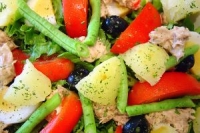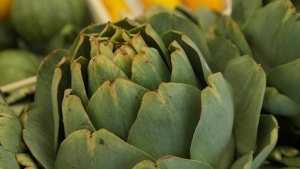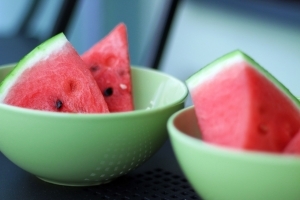Sautéed White Beans Provencal-Style
Sautéed White Beans Provencal-Style

Sautéed White Beans Provencal-Style Photo: Kathy Gunst Copyright 2020. All rights reserved.
Ingredients
· One 15-ounce can white beans, or any type of cooked bean or chick peas
· 2 tablespoons olive oil
· 2 cloves garlic
· 2 scallions or 1/3 cup chopped onion, optional
· 1 cup chopped cherry tomatoes or fresh tomatoes or canned tomatoes or sun-dried tomatoes
· 1/3 cup chopped roasted red peppers, optional
· 1 tablespoon dried or fresh rosemary, crumbled
· Salt and freshly ground black or white pepper
· About 1/4 cup white wine
· Grated lemon zest, optional
· Pinch dry red chili flakes, optional
Instructions
1. Drain the beans in a colander and rinse under cold running water. Drain again.
2. In a medium skillet heat the oil over low heat. Add the garlic and scallions (or onion) and cook 2 minutes. Add the tomatoes and rosemary and cook another 4 minutes. Add the roasted red pepper if you have it and then the drained beans and stir. Raise the heat to high and add the wine; bring to a rapid simmer. Reduce the heat and cook another 3 minutes or so until the wine is absorbed in beans slightly. Add salt and pepper to taste. Serve hot with crusty bread.
Recycled Vegetable Stock
Makes about 8 to 10 cups.
Ingredients
· About 1 to 2 pounds leftover vegetable scraps, about 4 to 5 cups, thoroughly washed and chopped
· 1 large stalks celery, chopped
· 3 peppercorns
· 1 bay leaf
· Salt to taste
· 1/2 cup parsley, chopped
Instructions
1. Place all the vegetable scraps, celery, peppercorns, bay leaf, salt and parsley in a large pot. Add enough cold water to just barely cover the vegetables. Bring to a boil over high heat, reduce the heat to low, partially cover, and let simmer for about an hour, or until flavorful. Push down on vegetables to fully immerse them in the boiling water. If the stock tastes weak, increase the heat and simmer to intensify the flavor for another 10 to 15 minutes. Taste for seasoning. Strain the stock.
Grape and Rosemary Foccacia
Rage Baking: The Transformative Power of Flour, Fury, and Women's Voices Kathy Gunst and Katherine Alford
MAKES ONE 18 X 13-INCH FOCACCIA; SERVES 8 TO 10
2 cups warm water (110°F)
3 tablespoons sugar
1 (¼-ounce) packet active dry yeast (2¼ teaspoons)
5 cups (600 grams) bread flour
9 tablespoons extra-virgin olive oil, plus more for greasing
1 tablespoon kosher salt, plus more or coarse sea salt for sprinkling
Cooking spray
1 pound red seedless grapes
2 teaspoons minced fresh rosemary leaves, plus sprigs for sprinkling
Freshly cracked black pepper
Pour ¼ cup of the warm water into a small bowl and add a generous pinch of the sugar. Sprinkle the yeast on the surface—don’t stir. Set aside until creamy and bubbling, about 5 minutes. In the bowl of a stand mixer, combine the remaining 1¾ cups warm water, remaining sugar, the flour, ¼ cup of the oil, and the salt and mix by hand with a wooden spoon to make a rough dough. Add the yeast mixture, attach the dough hook, and mix on medium-low speed for 10 minutes to make a soft, very slack dough that looks unmanageable but is not. (If needed, scrape down the sides of the bowl to combine.) The dough will be more like a wet batter. Brush a large bowl with a little oil. Use a flexible pastry scraper or rubber spatula to transfer the dough to the bowl.
Cover with plastic or reusable wrap or a clean kitchen towel and let rise in a warm place until the dough has doubled in size and large bubbles come to the surface, about 1 hour, depending on how warm the room is (see page 57). Brush a 13 x 9-inch baking pan with 2 tablespoons of the oil. Turn the dough out into the pan. Using the pastry scraper, press the dough out into a rectangle. Slip the pastry scraper under the edges of the dough and fold it in thirds like a letter. Rotate the dough 90 degrees and repeat the letter fold. (This easy kneading builds structure and coats the layers with oil.) Mist a piece of plastic or reusable wrap with cooking spray or brush it lightly with oil and cover the dough.
Refrigerate overnight or for up to 24 hours. Drizzle an 18 x 13-inch baking sheet with 2 tablespoons of the oil.
Transfer the cold dough to the baking sheet—again, the pastry scraper is your friend here. Cut a piece of parchment paper the size of the baking sheet and lightly brush it with oil or mist with cooking spray. Lay the oiled side of the parchment on top of the dough and press against the paper to stretch out the dough to fill the baking sheet. If the dough is resistant to stretching, wait for 10 minutes to allow it to relax, then try again. Remove the parchment. The dough needs to be covered but not with anything on the surface; I use another inverted baking sheet.
Let the dough rise until it fills the baking sheet and gets very light and pillowy, 2 to 2 hours 30 minutes. Meanwhile, position a rack in the lower third of the oven and preheat the oven to 425°F.
In a small oven-safe skillet or pan, toss the grapes with the remaining 1 tablespoon oil and season with salt. Roast until the grapes are juicy and slightly shriveled, about 10 minutes. Scatter the minced rosemary over the grapes and season generously with pepper. Let cool. Uncover the dough and gently drop the grapes into it (I am a super nerd and use chopsticks for this, but it’s fun to watch the grapes slip into the pillowy dough). Set aside until large air bubbles can be seen on the surface, about 20 minutes. Scatter sea salt and rosemary sprigs over the dough. Bake until golden brown, about 30 minutes. Run an offset spatula under the focaccia to release it from the baking sheet, then slip it onto a wire rack to cool. Serve warm or at room temperature.


